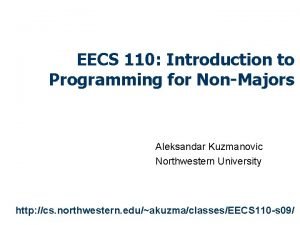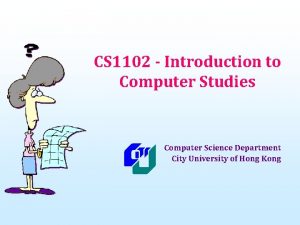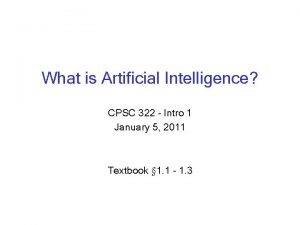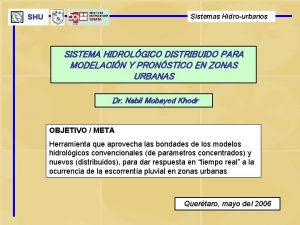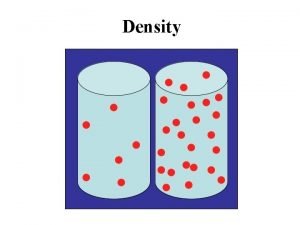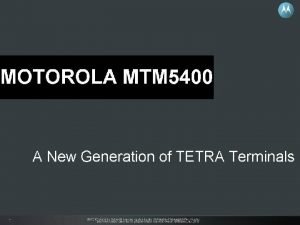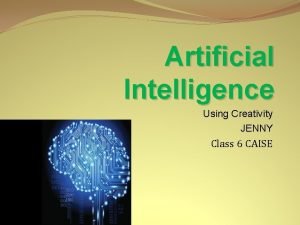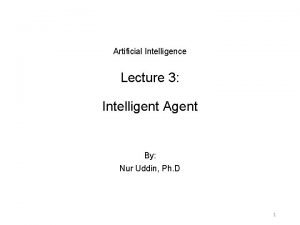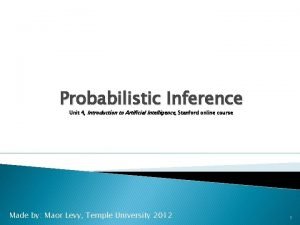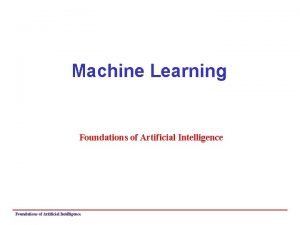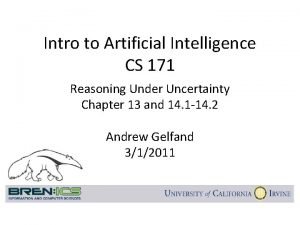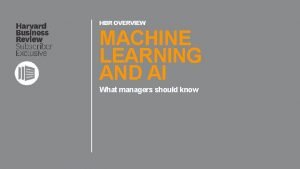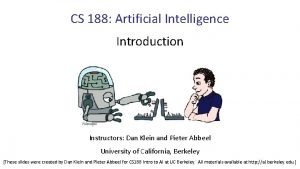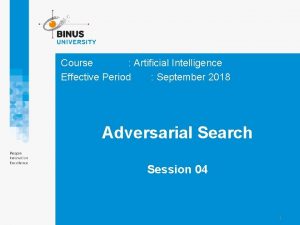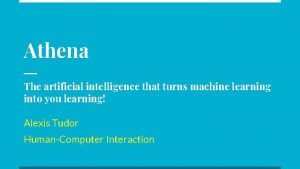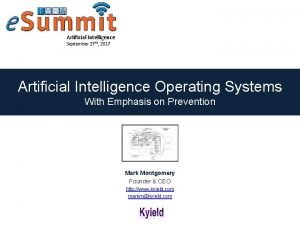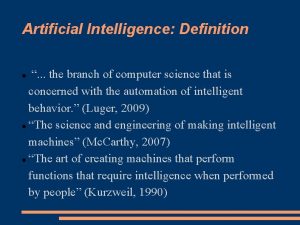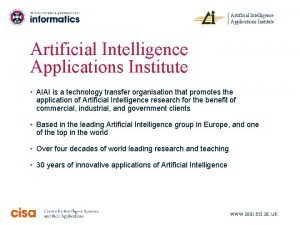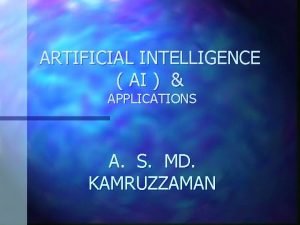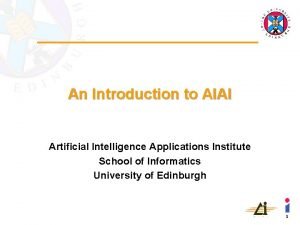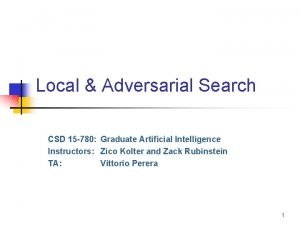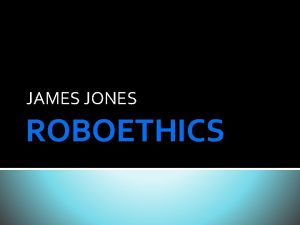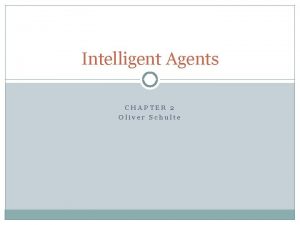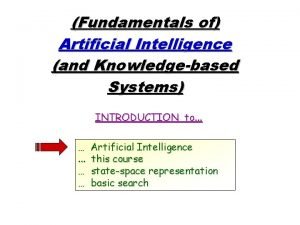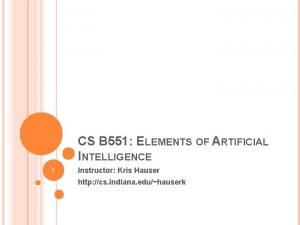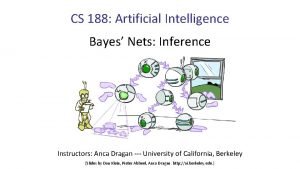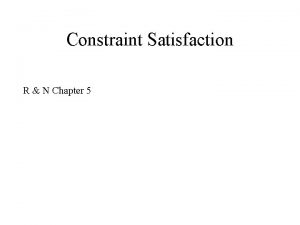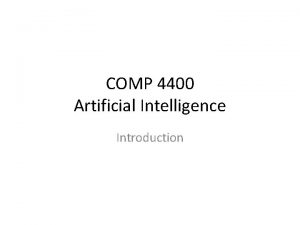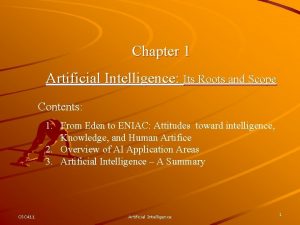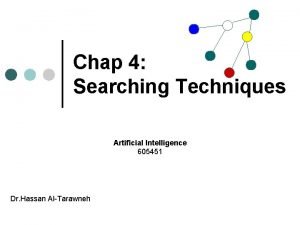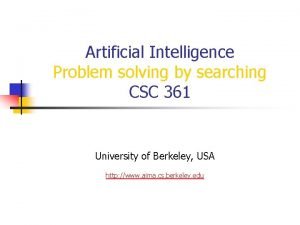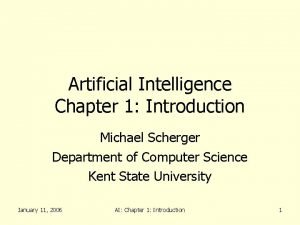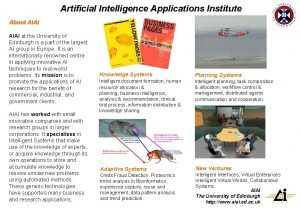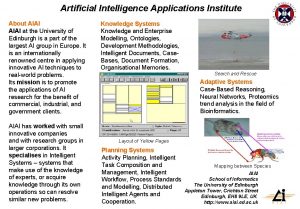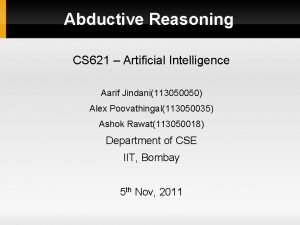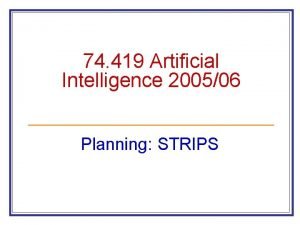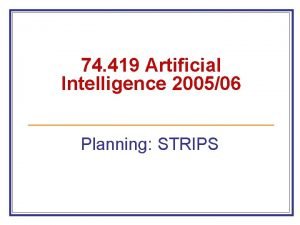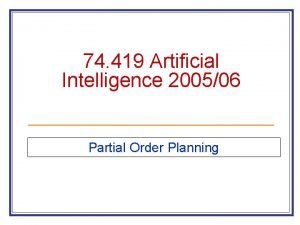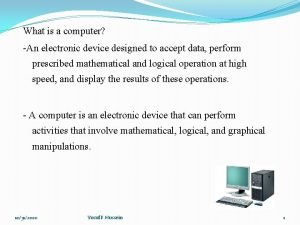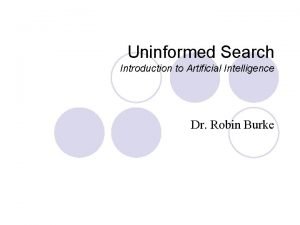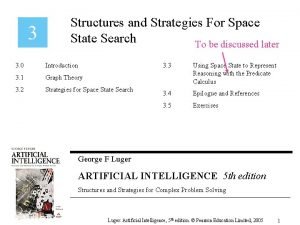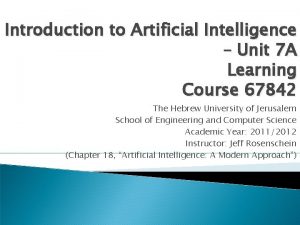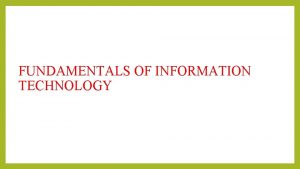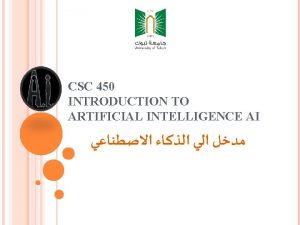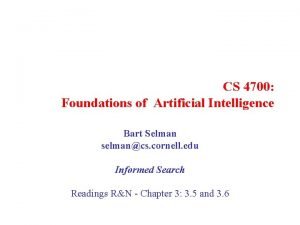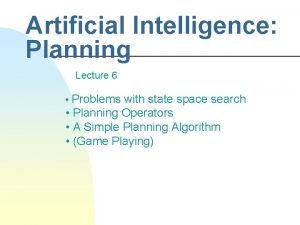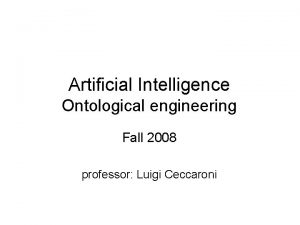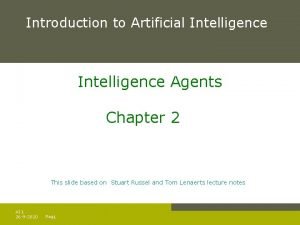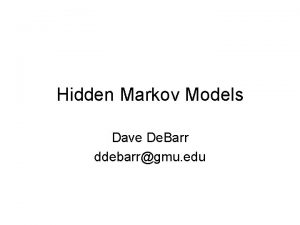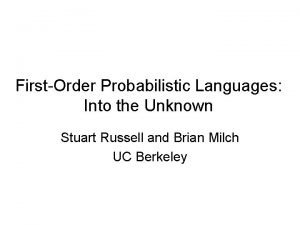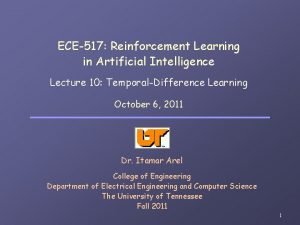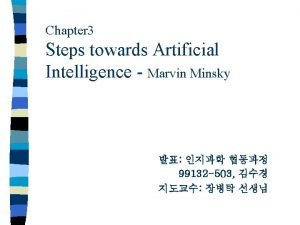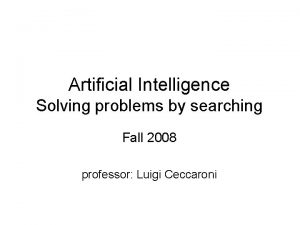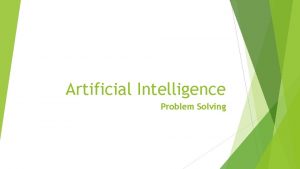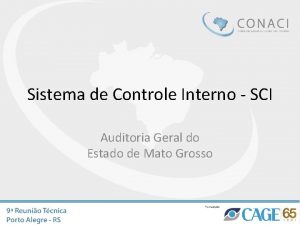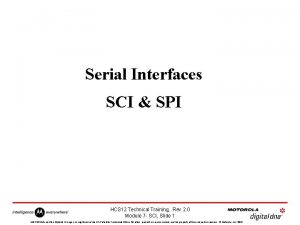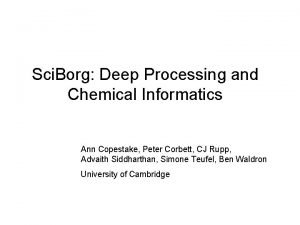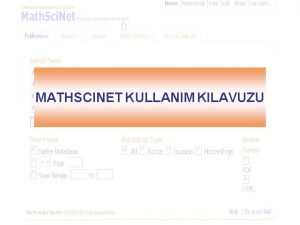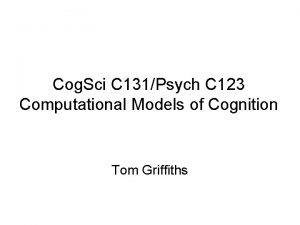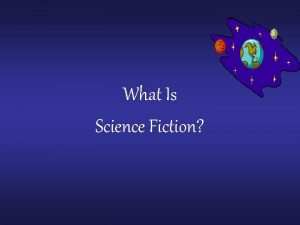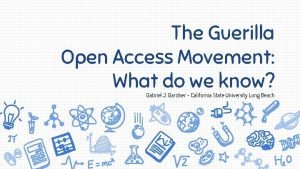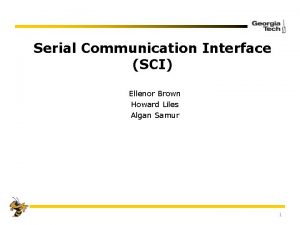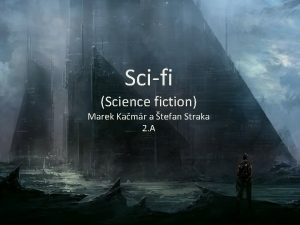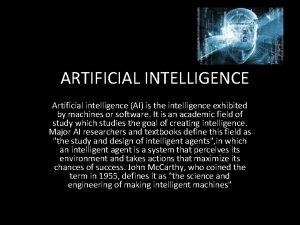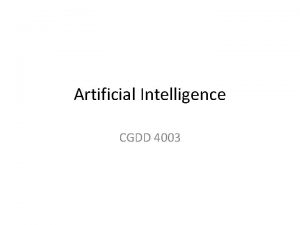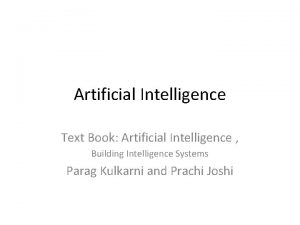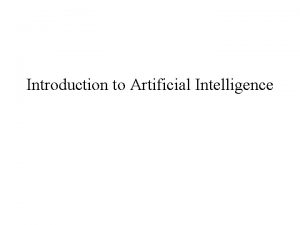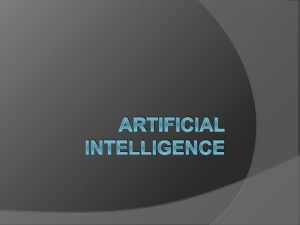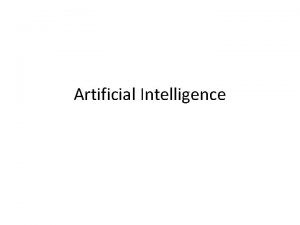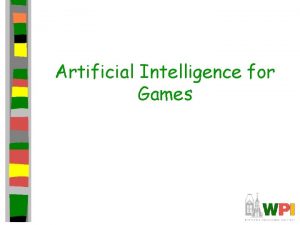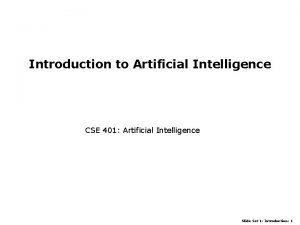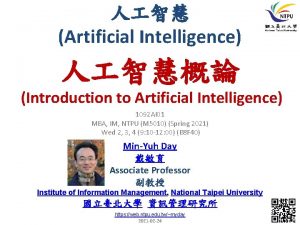COMP SCI 5400 Introduction to Artificial Intelligence general











































































































![Ethics • Autonomous AIs and the Trolley Dilemma [http: //www. trolleydilemma. com/] • Unemployment Ethics • Autonomous AIs and the Trolley Dilemma [http: //www. trolleydilemma. com/] • Unemployment](https://slidetodoc.com/presentation_image_h/190b64897612e7de1e94b5d468614fe0/image-108.jpg)


- Slides: 110

COMP SCI 5400 – Introduction to Artificial Intelligence general course website: http: //web. mst. edu/~tauritzd/courses/intro_AI. html Dr. Daniel Tauritz (Dr. T) Department of Computer Science tauritzd@mst. edu http: //web. mst. edu/~tauritzd/

What is AI? Systems that… –act like humans (Turing Test) –think like humans –think rationally –act rationally Play Ultimatum Game

Computer Agent • Perceives environment • Operates autonomously • Persists over prolonged periods

Rational Agents • Environment • Sensors (percepts) • Actuators (actions)


Rational Computer Agents • • • Environment Sensors (percepts) Actuators (actions) Agent Function Agent Program


Rational Behavior Depends on: • Agent’s performance measure • Agent’s prior knowledge • Possible percepts and actions • Agent’s percept sequence

Rational Agent Definition “For each possible percept sequence, a rational agent selects an action that is expected to maximize its performance measure, given the evidence provided by the percept sequence and any prior knowledge the agent has. ”

PEAS description & properties: –Fully/Partially Observable –Deterministic, Stochastic, Strategic –Episodic, Sequential –Static, Dynamic, Semi-dynamic –Discrete, Continuous –Single agent, Multiagent –Competitive, Cooperative –Known, Unknown

Agent Types • • • Simple Reflex Agents Model-Based Reflex Agents Goal-Based Agents Utility-Based Agents Learning Agents

Problem-solving agents A definition: Problem-solving agents are goal based agents that decide what to do based on an action sequence leading to a goal state.

Environment Assumptions • • • Fully Observable Single Agent Discrete Sequential Known & Deterministic

Open-loop problem-solving steps • Problem-formulation (actions & states) • Goal-formulation (states) • Search (action sequences) • Execute solution

Well-defined problems • • Initial state Action set: ACTIONS(s) Transition model: RESULT(s, a) Goal test Step cost: c(s, a, s’) Path cost Solution / optimal solution

Example problems • • Vacuum world Tic-tac-toe 8 -puzzle 8 -queens problem

Search trees • Root corresponds with initial state • Vacuum state space vs. search tree • Search algorithms iterate through goal testing and expanding a state until goal found • Order of state expansion is critical!

function TREE-SEARCH(problem) returns solution/fail initialize frontier using initial problem state loop do if empty(frontier) then return fail choose leaf node and remove it from frontier if chosen node contains goal state then return corresponding solution expand chosen node and add resulting nodes to frontier

Redundant paths • Loopy paths • Repeated states • Redundant paths

function GRAPH-SEARCH(problem) returns solution/fail initialize frontier using initial problem state initialize explored set to be empty loop do if empty(frontier) then return fail choose leaf node and remove it from frontier if chosen node contains goal state then return corresponding solution add chosen node to explored set expand chosen node and add resulting nodes to frontier only if not yet in frontier or explored set

Search node datastructure • • n. STATE n. PARENT-NODE n. ACTION n. PATH-COST States are NOT search nodes!

function CHILD-NODE(problem, parent, action) returns a node return a node with: STATE = problem. RESULT(parent. STATE, action) PARENT = parent ACTION = action PATH-COST = parent. PATH-COST + problem. STEP-COST(parent. STATE, action)

Frontier • Frontier = Set of leaf nodes • Implemented as a queue with ops: – EMPTY? (queue) – POP(queue) – INSERT(element, queue) • Queue types: FIFO, LIFO (stack), and priority queue

Explored Set • Explored Set = Set of expanded nodes • Implemented typically as a hash table for constant time insertion & lookup

Problem-solving performance • • Completeness Optimality Time complexity Space complexity

Complexity in AI • • b – branching factor d – depth of shallowest goal node m – max path length in state space Time complexity: # generated nodes Space complexity: max # nodes stored Search cost: time + space complexity Total cost: search + path cost

Class rules for execution traces • Order in which successors are generated is counterclockwise, ending at exactly 9 o’clock • When sorting by path-cost: – nodes with equal path-cost are ordered such that earlier generated nodes have higher priority – nodes already on the frontier have higher priority than newly added nodes with equal path-cost

Example state space #1

Breadth First Tree Search (BFTS) • Frontier: FIFO queue • Complete: if b and d are finite • Optimal: if path-cost is non-decreasing function of depth • Time complexity: O(b^d) • Space complexity: O(b^d)

Uniform Cost Search (UCS) • g(n) = lowest path-cost from start node to node n • Frontier: priority queue ordered by g(n)

Depth First Tree Search (DFTS) • Frontier: LIFO queue (a. k. a. stack) • Complete: no (DGFS is complete for finite state spaces) • Optimal: no • Time complexity: O(bm) • Space complexity: O(bm) • Backtracking version of DFTS: – space complexity: O(m) – modifies rather than copies state description

Depth-Limited Tree Search (DLTS) • • • Frontier: LIFO queue (a. k. a. stack) Complete: not when l < d Optimal: no Time complexity: O(bl) Space complexity: O(bl) Diameter: min # steps to get from any state to any other state

Diameter example 1

Diameter example 2

Iterative-Deepening Depth-First Tree Search (ID-DFTS) function ID-DFS(problem) returns solution/fail for depth = 0 to ∞ do result ← DLS(problem, depth) if result ≠ cutoff then return result • Complete: Yes, if b is finite • Optimal: Yes, if path-cost is nondecreasing function of depth • Time complexity: O(b^d) • Space complexity: O(bd)

Bidirectional Search Bi. BFTS • Complete: Yes, if b is finite • Optimal: Not “out of the box” • Time & Space complexity: O(bd/2)

Example state space #2

Best First Search (Be. FS) • Select node to expand based on evaluation function f(n) • Node with lowest f(n) selected as f(n) correlated with path-cost • Represent frontier with priority queue sorted in ascending order of f-values

Path-cost functions • g(n) = lowest path-cost from start node to node n • h(n) = estimated non-negative path-cost of cheapest path from node n to a goal node [with h(goal)=0]

Heuristics • h(n) is a heuristic function • Heuristics incorporate problemspecific knowledge • Heuristics need to be relatively efficient to compute

Important Be. FS algorithms • UCS: f(n) = g(n) • GBe. FS: f(n) = h(n) • A*S: f(n) = g(n)+h(n)

GBe. FTS • Incomplete (so also not optimal) • Worst-case time and space complexity: O(bm) • Actual complexity depends on accuracy of h(n)

A*S • f(n) = g(n) + h(n) • f(n): estimated cost of optimal solution through node n • if h(n) satisfies certain conditions, A*S is complete & optimal

Example state space # 3

Admissible heuristics • h(n) admissible if: Example: straight line distance A*TS optimal if h(n) admissible

Consistent heuristics • h(n) consistent if: Consistency implies admissibility A*GS optimal if h(n) consistent

A* search notes • • • Optimally efficient for consistent heuristics Run-time is a function of the heuristic error Suboptimal variants Not strictly admissible heuristics A* Graph Search not scalable due to memory requirements

Memory-bounded heuristic search • • • Iterative Deepening A* (IDA*) Recursive Best-First Search (RBFS) IDA* and RBFS don’t use all avail. memory Memory-bounded A* (MA*) Simplified MA* (SMA*) Meta-level learning aims to minimize total problem solving cost

Heuristic Functions • • Effective branching factor Domination Composite heuristics Generating admissible heuristics from relaxed problems

Sample relaxed problem • n-puzzle legal actions: Move from A to B if horizontally or vertically adjacent and B is blank Relaxed problems: (a)Move from A to B if adjacent (b)Move from A to B if B is blank (c) Move from A to B

Generating admissible heuristics The cost of an optimal solution to a relaxed problem is an admissible heuristic for the original problem.

Adversarial Search Environments characterized by: • Competitive multi-agent • Turn-taking Simplest type: Discrete, deterministic, two-player, zero-sum games of perfect information

Search problem formulation • • • S 0: Initial state (initial board setup) Player(s): which player has the move Actions(s): set of legal moves Result(s, a): defines transitional model Terminal test: game over! Utility function: associates playerdependent values with terminal states

Minimax • Time complexity: O(bm) • Space complexity: O(bm)

Example game tree 1

Depth-Limited Minimax • State Evaluation Heuristic estimates Minimax value of a node • Note that the Minimax value of a node is always calculated for the Max player, even when the Min player is at move in that node!

Heuristic Depth-Limited Minimax

State Eval Heuristic Qualities A good State Eval Heuristic should: (1)order the terminal states in the same way as the utility function (2)be relatively quick to compute (3)strongly correlate nonterminal states with chance of winning

Weighted Linear State Eval Heuristic

Heuristic Iterative-Deepening Minimax • IDM(s, d) calls DLM(s, 1), DLM(s, 2), …, DLM(s, d) • Advantages: –Solution availability when time is critical –Guiding information for deeper searches

Redundant info example

Alpha-Beta Pruning • α: worst value that Max will accept at this point of the search tree • β: worst value that Min will accept at this point of the search tree • Fail-low: encountered value <= α • Fail-high: encountered value >= β • Prune if fail-low for Min-player • Prune if fail-high for Max-player

DLM w/ Alpha-Beta Pruning Time Complexity • Worst-case: O(bd) • Best-case: O(bd/2) [Knuth & Moore, 1975] • Average-case: O(b 3 d/4)

Example game tree 2

Move Ordering Heuristics • Knowledge based (e. g. , try captures first in chess) • Principal Variant (PV) based • Killer Move: the last move at a given depth that caused αβ-pruning or had best minimax value • History Table: track how often a particular move at any depth caused αβpruning or had best minimax value

History Table (HT) • Option 1: generate set of legal moves and use HT value as f-value • Option 2: keep moves with HT values in a sorted array and for a given state traverse the array to find the legal move with the highest HT value

Example game tree 3

Search Depth Heuristics • Time based / State based • Horizon Effect: the phenomenon of deciding on a non-optimal principal variant because an ultimately unavoidable damaging move seems to be avoided by blocking it till passed the search depth • Singular Extensions / Quiescence Search

Time Per Move • • Constant Percentage of remaining time State dependent Hybrid

Quiescence Search • When search depth reached, compute quiescence state evaluation heuristic • If state quiescent, then proceed as usual; otherwise increase search depth if quiescence search depth not yet reached • Call format: QSDLM(root, depth, QSdepth), QSABDLM(root, depth, QSdepth, α, β), etc.

QS game tree Ex. 1

QS game tree Ex. 2

Transposition Tables (1) • Hash table of previously calculated state evaluation heuristic values • Speedup is particularly huge for iterative deepening search algorithms! • Good for chess because often repeated states in same search

Transposition Tables (2) • Datastructure: Hash table indexed by position • Element: – State evaluation heuristic value – Search depth of stored value – Hash key of position (to eliminate collisions) – (optional) Best move from position

Transposition Tables (3) • Zobrist hash key – Generate 3 d-array of random 64 -bit numbers (piece type, location and color) – Start with a 64 -bit hash key initialized to 0 – Loop through current position, XOR’ing hash key with Zobrist value of each piece found (note: once a key has been found, use an incremental approach that XOR’s the “from” location and the “to” location to move a piece)

Search versus lookup • Balancing time versus memory • Opening table – Human expert knowledge – Monte Carlo analysis • End game database

Forward pruning • Beam Search (n best moves) • Prob. Cut (forward pruning version of alpha-beta pruning)

Null Move Forward Pruning • Before regular search, perform shallower depth search (typically two ply less) with the opponent at move; if beta exceeded, then prune without performing regular search • Sacrifices optimality for great speed increase

Futility Pruning • If the current side to move is not in check, the current move about to be searched is not a capture and not a checking move, and the current positional score plus a certain margin (generally the score of a minor piece) would not improve alpha, then the current node is poor, and the last ply of searching can be aborted. • Extended Futility Pruning • Razoring


Adversarial Search in Stochastic Environments Worst Case Time Complexity: O(bmnm) with b the average branching factor, m the deepest search depth, and n the average chance branching factor

Example “chance” game tree

Expectiminimax & Pruning • Interval arithmetic • Monte Carlo simulations (for dice called a rollout)

State-Space Search • • Complete-state formulation Objective function Global optima Local optima (don’t use textbook’s definition!) • Ridges, plateaus, and shoulders • Random search and local search

Steepest-Ascent Hill-Climbing • Greedy Algorithm - makes locally optimal choices Example 8 queens problem has 88≈17 M states SAHC finds global optimum for 14% of instances in on average 4 steps (3 steps when stuck) SAHC w/ up to 100 consecutive sideways moves, finds global optimum for 94% of instances in on average 21 steps (64 steps when stuck)

Stochastic Hill-Climbing • Chooses at random from among uphill moves • Probability of selection can vary with the steepness of the uphill move • On average slower convergence, but also less chance of premature convergence

First-choice Hill-Climbing • Choose the first randomly generated uphill move • Greedy, incomplete, and suboptimal • Practical when the number of successors is large • Low chance of premature convergence as long as the move generation order is randomized

Random-restart Hill-Climbing • Series of HC searches from randomly generated initial states until goal is found • Trivially complete • E[# restarts]=1/p where p is probability of a successful HC given a random initial state • For 8 -queens instances with no sideways moves, p≈0. 14, so it takes ≈7 iterations to find a goal for a total of ≈22 steps

Simulated Annealing function SA(problem, schedule) returns solution state current←MAKE-NODE(problem. INITIAL-STATE) for t=1 to ∞ do T←schedule(t) if T=0 then return current next←RANDOM-SUCCESOR(current) ∆E←next. VALUE – current. VALUE if ∆E > 0 then current←next else current←next with probability of e∆E/T

Population Based Local Search • • • Deterministic local beam search Stochastic local beam search Evolutionary Algorithms Particle Swarm Optimization Ant Colony Optimization

Particle Swarm Optimization • PSO is a stochastic population-based optimization technique which assigns velocities to population members encoding trial solutions • PSO update rules: PSO demo: http: //www. borgelt. net/psopt. html

Ant Colony Optimization • Population based • Pheromone trail and stigmergetic communication • Shortest path searching • Stochastic moves ACO demo: http: //www. borgelt. net/acopt. html

Online Search • • • Offline search vs. online search Interleaving computation & action Dynamic, nondeterministic, unknown domains Exploration problems, safely explorable Agents have access to: – ACTIONS(s) – c(s, a, s’) cannot be used until RESULT(s, a) – GOAL-TEST(s)

Online Search Optimality • CR – Competitive Ratio • TAPC – Total Actual Path Cost • C* - Optimal Path Cost • Best case: CR = 1 • Worst case: CR = ∞

Online Search Algorithms • Online-DFS-Agent • Online Local Search • Learning Real-Time A* (LRTA*)

function ONLINE-DFS-AGENT(s’) returns action persistent: result, untried, unbacktracked, s, a if GOAL-TEST(s’) then return stop if s’ is a new state then untried[s’]←ACTIONS(s’) if s is not null then result[s, a]←s’ add s to front of unbacktracked[s’] if untried[s’] is empty then if unbacktracked[s’] is empty then return stop else a←action b so result[s’, b]=POP(unbacktracked[s’]) else a←POP(untried[s’]) s←s’ return a

Online Local Search • • Locality in node expansions Inherently online Not useful in base form Random Walk

function LRTA*-AGENT(s’) returns action persistent: result, H, s, a if GOAL-TEST(s’) then return stop if s’ is a new state then H[s’]←h(s’) if s is not null then result[s, a]←s’ H[s]←minbϵACTIONS(s)LRTA*-COST(s, b, result[s, b], H) a←bϵACTIONS to minimize LRTA*-COST(s’, b, result[s’, b], H) s←s’ return a function LRTA*-COST(s, a, s’, H) returns a cost estimate if s’ is undefined then return h(s) else return c(s, a, s’)+H[s’]

Online Search Maze Problem (Fig. 4. 19)

Online Search Example Graph 1 a

Online Search Example Graph 1 b

Online Search Example Graph 2

Online Search Example Graph 3

Key historical events for AI • • 4 th century BC Aristotle propositional logic 1600’s Descartes mind-body connection 1805 First programmable machine Mid 1800’s Charles Babbage’s “difference engine” & “analytical engine” • Lady Lovelace’s Objection • 1847 George Boole propositional logic • 1879 Gottlob Frege predicate logic

Key historical events for AI • 1931 Kurt Godel: Incompleteness Theorem In any language expressive enough to describe natural number properties, there are undecidable (incomputable) true statements • 1943 Mc. Culloch & Pitts: Neural Computation • 1956 Term “AI” coined • 1976 Newell & Simon’s “Physical Symbol System Hypothesis” A physical symbol system has the necessary and sufficient means for general intelligent action.

Key historical events for AI • • • AI Winters (1974 -80, 1987 -93) Commercialization of AI (1980 -) Rebirth of Artificial Neural Networks (1986 -) Unification of Evolutionary Computation (1990 s) Rise of Deep Learning (2000 s)

Weak AI vs. Strong AI • Weak AI Hypothesis: It’s possible to create machines that can act as if they’re intelligent • Strong AI Hypothesis: It’s possible to create machines that actually think • Mind-Body Problem ØRené Descartes (1596 -1650) ØRationalism, Dualism, Materialism, Brain in a vat ØStar Trek & Souls • Chinese Room
![Ethics Autonomous AIs and the Trolley Dilemma http www trolleydilemma com Unemployment Ethics • Autonomous AIs and the Trolley Dilemma [http: //www. trolleydilemma. com/] • Unemployment](https://slidetodoc.com/presentation_image_h/190b64897612e7de1e94b5d468614fe0/image-108.jpg)
Ethics • Autonomous AIs and the Trolley Dilemma [http: //www. trolleydilemma. com/] • Unemployment & Inequality • Human dependency & obsoleteness [https: //www. technologyreview. com/s/610456/ a-startup-is-pitching-a-mind-uploading-service -that-is-100 -percent-fatal/] • Bias transfer • Security • Human-robot relationships • Rights of sentient beings

How difficult is it to achieve AI? • Three Sisters Puzzle

AI(ish) courses/offerings at S&T • • • • CS 3001 Introduction to Data Science (FS 2018) CS 5001 Introduction to Deep Learning (FS 2018) CS 5400 Introduction to Artificial Intelligence (SP 2019) CS 5401 Evolutionary Computing (FS 2018) CS 5402 Introduction to Data Mining (SS 2018) CS 5404 Intro to Computer Vision (FS 2019) CS 6001 Machine Learning in Computer Vision (SP 2016, SP 2017) CS 6400 Advanced Topics in AI (SP 2013) CS 6401 Advanced Evolutionary Computing (SP 2016) CS 6402 Advanced Topics in Data Mining (SP 2018) CS 6405 Clustering Algorithms Cp. E 5310 Computational Intelligence Cp. E 5460 Machine Vision Eng. Mgt 5413 Introduction to Intelligent Systems Sys. Eng 5212 Introduction to Neural Networks and Applications Sys. Eng 6213 Advanced Neural Networks
 Ap csa recursion
Ap csa recursion Cs110 northwestern
Cs110 northwestern Comp sci 1102
Comp sci 1102 Comp sci 1027
Comp sci 1027 Zjhz
Zjhz Introduction to artificial intelligence and expert systems
Introduction to artificial intelligence and expert systems Cpsc 322: introduction to artificial intelligence
Cpsc 322: introduction to artificial intelligence Cpsc 322 ubc
Cpsc 322 ubc Presa shu
Presa shu Density of water in kg/m3
Density of water in kg/m3 How to patent a logo
How to patent a logo Xoon expert system in artificial intelligence
Xoon expert system in artificial intelligence State space artificial intelligence
State space artificial intelligence Searching for solutions in artificial intelligence
Searching for solutions in artificial intelligence 15-780 graduate artificial intelligence
15-780 graduate artificial intelligence Knowledge manipulation in artificial intelligence
Knowledge manipulation in artificial intelligence Types of knowledge in ai
Types of knowledge in ai Vandelay art. seinfeld the show about nothing. penguin 1997
Vandelay art. seinfeld the show about nothing. penguin 1997 Kecerdasan kepemimpinan
Kecerdasan kepemimpinan Uas kecerdasan buatan
Uas kecerdasan buatan Math for artificial intelligence
Math for artificial intelligence Peas description for interactive english tutor
Peas description for interactive english tutor 15-780 graduate artificial intelligence
15-780 graduate artificial intelligence Analogizers
Analogizers A fuzzy proposition
A fuzzy proposition Asu cse 571
Asu cse 571 15-780 graduate artificial intelligence
15-780 graduate artificial intelligence What is informed search and uninformed search
What is informed search and uninformed search Artificial intelligence for class 6
Artificial intelligence for class 6 Augmented grammar in ai
Augmented grammar in ai Omniscience in artificial intelligence
Omniscience in artificial intelligence Int404
Int404 Artificial intelligence chapter 3
Artificial intelligence chapter 3 Partitioned semantic network in artificial intelligence
Partitioned semantic network in artificial intelligence A* algorithm and ao* algorithm
A* algorithm and ao* algorithm Artificial intelligence thesis proposals
Artificial intelligence thesis proposals Rule based deduction system in artificial intelligence
Rule based deduction system in artificial intelligence Inference by enumeration in artificial intelligence
Inference by enumeration in artificial intelligence Rote learning in artificial intelligence
Rote learning in artificial intelligence Water jug problem production rules
Water jug problem production rules Optimal decisions in games in artificial intelligence
Optimal decisions in games in artificial intelligence Hbr machine learning
Hbr machine learning Cs188 artificial intelligence
Cs188 artificial intelligence Optimal decisions in games in artificial intelligence
Optimal decisions in games in artificial intelligence Athena machine learning
Athena machine learning Artificial intelligence operating system
Artificial intelligence operating system Ahead ea wall
Ahead ea wall Artificial intelligence is a branch of computer science
Artificial intelligence is a branch of computer science Artificial intelligence applications institute
Artificial intelligence applications institute Conclusion of artificial intelligence
Conclusion of artificial intelligence Artificial intelligence applications institute
Artificial intelligence applications institute Which search strategy is also called as blind search?
Which search strategy is also called as blind search? 15-780 graduate artificial intelligence
15-780 graduate artificial intelligence Ethics of artificial intelligence
Ethics of artificial intelligence Part picking robot peas
Part picking robot peas Fundamentals of artificial intelligence
Fundamentals of artificial intelligence Csci-b 551 elements of artificial intelligence
Csci-b 551 elements of artificial intelligence Inference by enumeration in artificial intelligence
Inference by enumeration in artificial intelligence Waltz algorithm in artificial intelligence
Waltz algorithm in artificial intelligence Artificial intelligence examples
Artificial intelligence examples Conceptual graph in artificial intelligence tutorial
Conceptual graph in artificial intelligence tutorial Artificial intelligence chapter 1
Artificial intelligence chapter 1 Best for search
Best for search Artificial intelligence the next digital frontier?
Artificial intelligence the next digital frontier? Problem solving by searching in artificial intelligence
Problem solving by searching in artificial intelligence Artificial intelligence chapter 1
Artificial intelligence chapter 1 Artificial intelligence chapter 1
Artificial intelligence chapter 1 Artificial intelligence applications institute
Artificial intelligence applications institute Artificial intelligence applications institute
Artificial intelligence applications institute Artificial intelligence
Artificial intelligence Strips planning in artificial intelligence
Strips planning in artificial intelligence Strips planning example
Strips planning example Total order planning in artificial intelligence
Total order planning in artificial intelligence Electronic device designed to accept data
Electronic device designed to accept data Uninformed search in artificial intelligence
Uninformed search in artificial intelligence Artificial intelligence graph
Artificial intelligence graph Snapdragon artificial intelligence
Snapdragon artificial intelligence Unit 7 artificial intelligence
Unit 7 artificial intelligence Trade promotion machine learning
Trade promotion machine learning Artificial intelligence devices
Artificial intelligence devices Artificial intelligence
Artificial intelligence Artificial intelligence
Artificial intelligence Artificial intelligence devices
Artificial intelligence devices Aima slides
Aima slides Planning in artificial intelligence
Planning in artificial intelligence Ontological engineering in artificial intelligence
Ontological engineering in artificial intelligence Artificial intelligence devices
Artificial intelligence devices Artificial intelligence devices
Artificial intelligence devices Artificial intelligence
Artificial intelligence References for artificial intelligence
References for artificial intelligence Types of agents in artificial intelligence
Types of agents in artificial intelligence Artificial intelligence: a modern approach
Artificial intelligence: a modern approach Artificial intelligence: a modern approach
Artificial intelligence: a modern approach Bin zaid face
Bin zaid face Passive reinforcement learning in artificial intelligence
Passive reinforcement learning in artificial intelligence Coordinated plan on artificial intelligence
Coordinated plan on artificial intelligence Steps towards artificial intelligence
Steps towards artificial intelligence Solving problems by searching artificial intelligence
Solving problems by searching artificial intelligence Artificial intelligence
Artificial intelligence Umass poli sci
Umass poli sci Sci technology work from home
Sci technology work from home Sci auditoria
Sci auditoria Spi vs sci
Spi vs sci Scigateway
Scigateway Sci borg
Sci borg Math sci
Math sci Cogsci 131
Cogsci 131 What's science fiction
What's science fiction Friends
Friends Sci communication
Sci communication Znaky sci fi
Znaky sci fi

